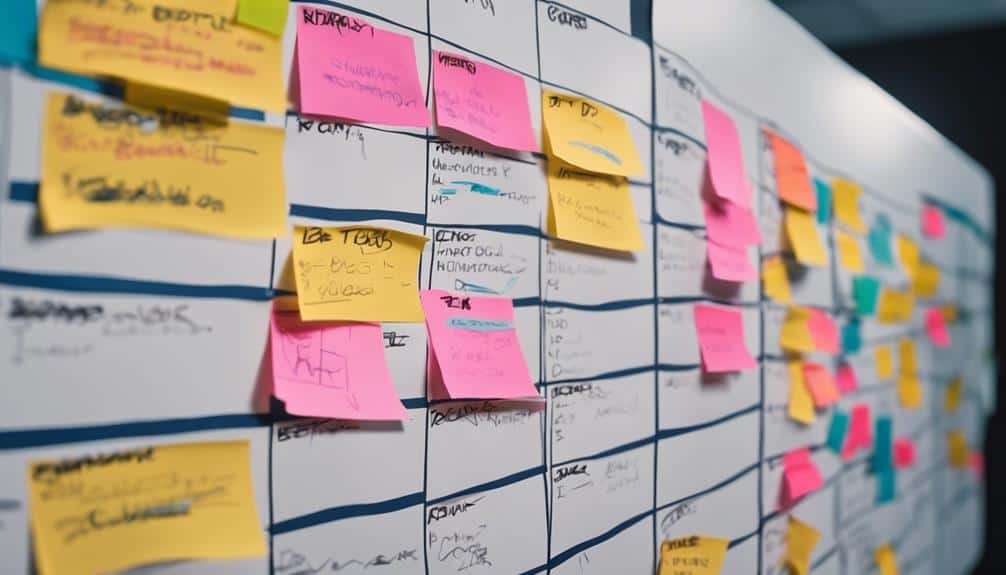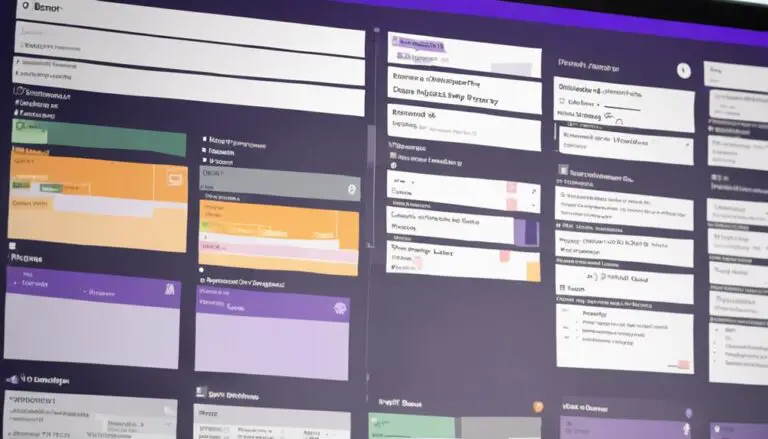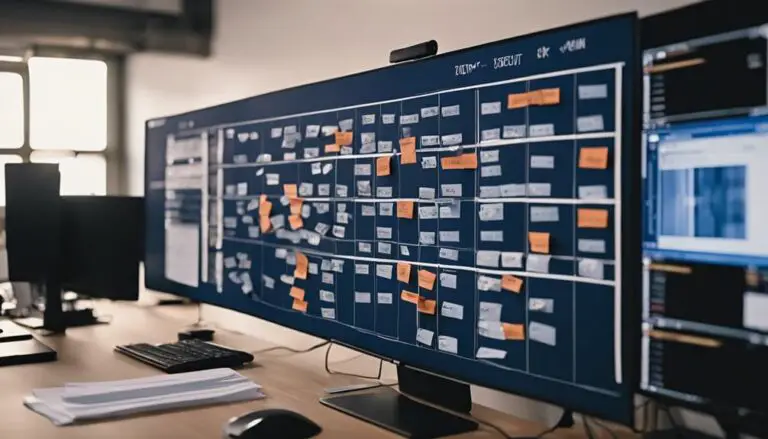In a SAFe environment, you can deploy Kanban to streamline workflows and boost productivity within your Agile Release Train (ART). By incorporating Kanban boards and WIP limits, teams can optimize their workflow management and enhance collaboration.
But how exactly do you adapt Kanban principles to the scale and complexity of SAFe? Let's explore the nuanced strategies and benefits that come with integrating Kanban in a SAFe environment to drive efficiency and continuous improvement.
Key Takeaways
- Align team's work with Program Increment durations for efficient delivery.
- Utilize Kanban boards to prioritize tasks and track progress effectively.
- Enhance collaboration and communication to boost team productivity.
- Visualize work progress, limit WIP, and continuously improve workflows for value delivery.
Implementing Kanban in SAFe
To successfully implement Kanban in a SAFe environment, align your team's work with the Program Increment (PI) durations and guidelines while utilizing Kanban boards for task prioritization and progress tracking. By integrating Kanban into your Agile project management approach within the SAFe framework, you can enhance your team's efficiency and effectiveness.
Kanban boards offer a visual representation of work items, allowing teams to see what needs to be done, what's in progress, and what's been completed. This transparency fosters collaboration and empowers teams to make data-driven decisions in real-time.
In organizations with multiple interdependent projects, the combination of SAFe and Kanban provides a structured yet flexible approach to managing work. By aligning your team's tasks with the overall Program Increment objectives, you ensure that everyone is working towards the same goals. As priorities shift or new information emerges, Kanban enables teams to adapt quickly, reprioritize tasks, and stay on track to deliver value efficiently.
Embracing Kanban within the SAFe environment promotes a culture of continuous improvement and empowers teams to optimize their Agile methodologies for better outcomes.
Enhancing Team Collaboration With Kanban
Enhance your team's collaboration and transparency by utilizing Kanban boards to visualize work progress effectively. When implementing Kanban in a SAFe environment, team collaboration is key to success. Here's how you can achieve this:
- Promote Open Communication: Kanban boards act as a central hub where team members can see what everyone is working on, fostering open communication and collaboration.
- Encourage Collective Decision-Making: By visualizing work progress on Kanban boards, teams can collectively make decisions on task prioritization and allocation.
- Facilitate Shared Accountability: With Kanban, every team member can see the status of tasks, promoting shared responsibility and accountability for the project's success.
- Improve Workflow Efficiency: Visualizing work on Kanban boards helps in identifying bottlenecks, optimizing workflow efficiency, and ensuring tasks move smoothly across the board.
Streamlining Workflows in SAFe With Kanban
When streamlining workflows in SAFe with Kanban, focus on:
- Visualizing work progress
- Limiting work in progress
- Continuously improving flow
By implementing these key points, you can enhance efficiency, prioritize effectively, and ensure a steady delivery of value.
Embrace transparency, collaboration, and adaptability to align with the Agile Release Train cadence and optimize your team's performance.
Visualizing Work Progress
Visualizing work progress in a SAFe environment with Kanban involves creating a flow-based system that represents work items on a Kanban board, streamlining workflows for efficient tracking and management at every level of the Framework.
To effectively visualize and manage work progress:
- Utilize a Kanban board: Implement a visual board to track tasks and their progress in real-time.
- Monitor the flow of work: Keep an eye on how tasks move through different stages to ensure smooth progress.
- Identify bottlenecks: Use Kanban to pinpoint areas where work is getting stuck or delayed.
- Focus on delivering value: Align your efforts towards delivering value to customers promptly and consistently.
Limiting Work in Progress
To streamline workflows effectively in a SAFe environment with Kanban, implement WIP limits on your Kanban board to regulate the number of work items in progress at any one time. Setting WIP limits in Kanban within the SAFe framework ensures that team members aren't overwhelmed with too many tasks simultaneously, allowing them to focus and complete work efficiently.
By having these limits, teams can avoid multitasking, which in turn enhances productivity. Visualizing these WIP limits on the Kanban board helps teams identify bottlenecks, prioritize effectively, and maintain a steady flow of work.
Embracing WIP limits fosters collaboration among team members, encourages continuous improvement, and promotes incremental value delivery, all essential aspects within the SAFe environment.
Continuous Flow Improvement
Implementing continuous flow improvement practices in a SAFe environment with Kanban enables teams to enhance workflow efficiency and optimize value delivery within the Agile Release Train (ART).
Here are four key ways Kanban facilitates work flowing and helps teams manage their work effectively in the Agile landscape:
- Visualizing Work: Kanban boards allow teams to see tasks at each stage, promoting transparency and alignment.
- Setting WIP Limits: Establishing limits on work in progress prevents overloading, ensuring smoother flow and focus.
- Identifying Bottlenecks: Kanban highlights areas of congestion, enabling teams to address bottlenecks promptly.
- Incremental Process Improvement: By continuously refining their process, teams can enhance productivity and adapt to changing Agile requirements.
Leveraging Kanban Principles in SAFe
By incorporating Kanban principles into a SAFe environment, teams can streamline their workflow, prioritize effectively, and easily adapt to changing priorities. SAFe Kanban teams benefit from managing work efficiently by visualizing workflow, setting WIP limits, and measuring throughput for continuous improvement. This approach enhances transparency and increases collaboration, ensuring continuous value delivery within SAFe.
Leveraging Kanban principles in SAFe provides flexibility, autonomy, and clear visibility into work progress at both the team and portfolio levels. It promotes adaptive planning, relentless improvement, and efficient coordination of work within Agile Release Trains. By embracing Kanban in SAFe, you empower your teams to work smarter, make data-driven decisions, and foster a culture of continuous learning and growth.
Together, by integrating these principles, you can achieve higher efficiency, better outcomes, and a more adaptive and responsive way of working.
Optimizing Productivity With Kanban in SAFe
Pivoting from leveraging Kanban principles in a SAFe environment, optimizing productivity with Kanban in SAFe is key to enhancing workflow efficiency and achieving continuous value delivery.
To manage work items effectively and maximize productivity within Agile Teams, consider the following strategies:
- Visualizing Workflow: Utilize Kanban boards to visualize work stages, identify bottlenecks, and streamline the flow of work items efficiently.
- Setting WIP Limits: Implement Work In Progress (WIP) limits to prevent overloading teams, maintain focus, and ensure steady progress on tasks.
- Tracking Throughput: Monitor the rate at which work items are completed to assess team performance, identify areas for improvement, and optimize productivity.
- Optimizing Work in Progress: Continuously refine processes, adjust priorities, and collaborate effectively to deliver value consistently and meet iteration goals.
Delivering Value Using Kanban in SAFe
Let's focus on delivering value through Kanban in your SAFe environment.
By leveraging Value Stream Mapping, you can identify and eliminate inefficiencies, allowing for a continuous flow approach that enhances productivity.
Visualizing work progress ensures transparency and enables teams to make data-driven decisions, ultimately leading to delivering value efficiently.
Value Stream Mapping
Visualizing the end-to-end process of delivering value using Kanban in a SAFe environment is integral to enhancing efficiency and optimizing workflow. When implementing Value Stream Mapping in your business, consider the following:
- Identify Waste: Pinpoint inefficiencies and bottlenecks to streamline operations.
- Improve Flow: Enhance the movement of work items through the system for faster delivery.
- Reduce Lead Times: Minimize delays and accelerate the time it takes to deliver value.
- Enhance Collaboration: Foster teamwork and communication to ensure a smooth flow of work within the Agile Release Train (ART).
Continuous Flow Approach
To optimize value delivery in a SAFe environment using Kanban, the Continuous Flow Approach focuses on managing work items efficiently and ensuring a steady flow of value-added activities. By implementing Kanban systems, agile teams in SAFe environments can track work items seamlessly from backlog to completion. Limiting work in progress (WIP) through Kanban promotes a continuous flow of value-added tasks, allowing teams to adapt to changing priorities and deliver incremental value.
This approach enables teams to visualize and optimize the flow of work, ensuring that value is consistently being delivered. In SAFe environments, leveraging the continuous flow approach of Kanban empowers teams to streamline their processes and enhance overall value delivery.
Visualizing Work Progress
To successfully track and manage work items for delivering value in a SAFe environment using Kanban, teams utilize a visual Kanban board with designated columns and work-in-progress limits.
Here are four essential aspects of visualizing work progress with Kanban in SAFe teams:
- Visual Representation: Kanban cards on the board visually represent specific tasks, providing a clear overview of the work in progress.
- Workflow Efficiency: By using swimlanes to group related work items, teams define the workflow and ensure tasks move smoothly from 'To do' to 'Done'.
- WIP Limits: Setting Work In Process limits helps manage the flow of work efficiently, preventing bottlenecks and overburdening team members.
- Enhanced Coordination: Kanban in SAFe enhances transparency and coordination by providing a visual representation of the workflow, fostering collaboration and continuous value delivery.
Frequently Asked Questions
How Is Kanban Used in Safe?
In a SAFe environment, Kanban is utilized to enhance team collaboration, visualize work, promote continuous improvement, set work in progress limits, offer flexibility in planning, and limit bottlenecks. It fosters a culture of efficiency and adaptability.
What Is the Benefit of Using Kanban With a SAFe Portfolio?
Enhanced efficiency and improved visibility with Kanban in a SAFe Portfolio streamline workflows and aid in better prioritization. Increased collaboration and continuous improvement are fostered, aligning strategic initiatives with business objectives for optimal outcomes.
What Is the Best Way to Use Kanban?
To use Kanban effectively, focus on visualizing workflow, setting WIP limits, and collaborating with your team. Improve processes continuously, align with Agile principles, and prioritize tasks. By enhancing transparency and optimizing flow, you'll boost efficiency.
In What Ways Do You Think This Kanban Could Be Effective?
To be effective, consider how Kanban enhances team collaboration, visual management, task prioritization, efficiency tracking, cycle time, and bottleneck identification. Embrace continuous improvement, workflow optimization, and lean principles for successful project management in a SAFe environment.
Conclusion
Congratulations! By implementing Kanban in a SAFe environment, you have unlocked the ultimate key to productivity and efficiency. You have streamlined workflows, enhanced team collaboration, and optimized your processes like never before. Applying kanban effectively has allowed your team to visually track and prioritize tasks, leading to a more organized and transparent work environment. By using kanban, you have also gained valuable insight into your team’s capacity and bottlenecks, enabling you to make data-driven decisions for continuous improvement. Overall, your commitment to using kanban in a SAFe environment has truly revolutionized the way your team operates, setting the stage for even greater success in the future.
With Kanban, you're not just delivering value – you're exceeding expectations and setting new standards for success. Keep up the great work and continue to harness the power of Kanban to drive continuous improvement and innovation in your organization!





